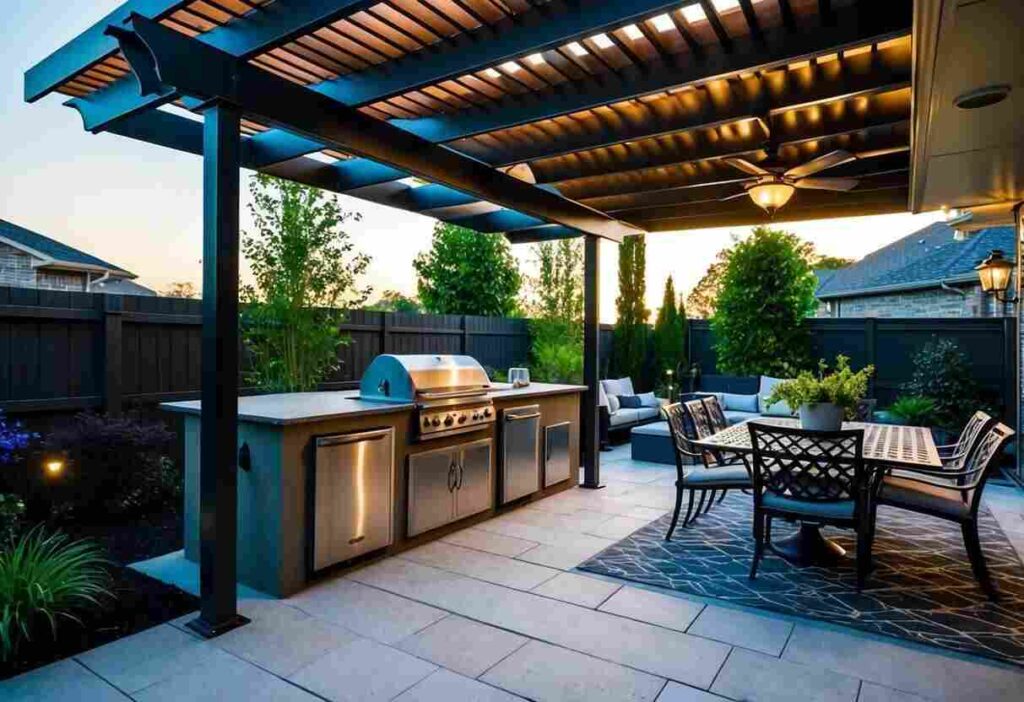Creating an outdoor living space that combines durability with modern aesthetics can be achieved through the use of steel structures. Steel offers strength and versatility, making it an ideal choice for constructing pergolas, canopies, and outdoor pavilions. These structures not only enhance the visual appeal of gardens and patios but also provide practical solutions for weather protection and space definition.
Using steel, homeowners can design customizable spaces that suit various styles and functions. Whether it’s a sleek, minimalist design or a more ornate style, steel allows for creativity and flexibility in architecture. Steel’s resilience to environmental factors ensures that these outdoor spaces remain sturdy and safe over time, making it a sustainable and long-term investment.
Incorporating steel structures also opens opportunities for integrating modern features like built-in lighting or heating elements, adding comfort and convenience to outdoor areas. By choosing steel, individuals can enjoy the benefits of personalizing their environment with an emphasis on both form and function.
Design Considerations for Steel Structures in Outdoor Spaces
Selecting steel for outdoor living spaces involves assessing the interplay of material characteristics, local environmental factors, and aesthetic requirements. These factors influence the practicality and longevity of the structure. With the diversity of customization options and durability concerns, careful planning ensures the design meets both functional and visual needs.
Understanding Material Characteristics
The characteristics of steel, such as tensile strength and flexibility, make it an ideal choice for outdoor structures. Its ability to withstand high stress without deformation ensures durability.
Steel’s resistance to pests and environmental wear allows it to maintain structural integrity over time. It’s important to consider the type of steel alloy used. Each offers different benefits, like increased resistance to rust or enhanced strength. Suppliers, including those in New Hampshire, provide a variety of alloy options tailored to specific design needs.
Coatings such as galvanization or powder coating further protect steel from corrosion. These coatings are crucial in extending the life of steel structures, particularly in environments with high humidity or salinity.
Environmental Factors and Durability
Weather conditions greatly affect the durability of steel structures. Structures in areas prone to heavy snow need additional reinforcement to avoid strain. In coastal regions, corrosion from saltwater can be a concern.
The choice of steel should match the environment. Well-chosen coatings provide an extra layer of defense against corrosion, ensuring longevity. A metal building supplier in New Hampshire can recommend steel grades and finishes best suited for local conditions.
Thermal expansion is another consideration. Temperature fluctuations can lead to steel expansion and contraction. Proper engineering and material choice mitigate potential issues, preserving the structure’s integrity over time.
Aesthetic Appeal and Customization
Steel offers a unique blend of strength and adaptability, lending itself to various design styles. It can be styled to match both modern and traditional aesthetics, with a sleek appearance that complements natural landscapes.
Customizable elements such as color and finish allow for creative expression. This includes a range of paint colors and textured coatings. Metal building suppliers offer design services to personalize projects, ensuring the final structure meets aesthetic expectations.
Incorporating other materials, such as wood or glass, enhances visual appeal and enables a harmonious integration with existing outdoor spaces. This versatility makes steel structures attractive for customized outdoor living spaces.
Implementation and Maintenance
Implementing steel structures in outdoor living spaces requires careful planning and construction, with a focus on safety and durability. Maintenance tasks are vital to ensure longevity and prevent structural issues.
Installation Process
The installation of steel structures begins with site preparation. Ensuring a solid foundation is critical to support the framework. Professionals often use concrete slabs or piers for anchoring. Once the base is secure, the steel components are assembled, typically involving bolting or welding.
Precision in alignment is crucial. Measurements must be repeatedly verified to avoid discrepancies. Use of quality materials and proper tools ensures a seamless fit. Enabling weather resistance through coatings or paints is recommended, providing a layer of protection against corrosion and environmental factors.
Safety Guidelines and Standards
Adhering to safety guidelines during installation is non-negotiable. Local building codes must be followed to ensure that the structure can withstand weather forces. Professionals should be certified and experienced in handling steel materials.
Personal protective equipment (PPE) is essential for all workers. This includes helmets, gloves, and harnesses when required. Safety inspections before, during, and after construction minimize risks. Regular audits and compliance checks maintain the integrity of the structure and meet legal requirements.
Long-Term Care and Upkeep
Regular maintenance of steel structures extends their lifespan. Inspecting for rust or any wear-and-tear informs necessary repairs. Rust protection can be applied periodically to guard against moisture and oxidation.
Cleaning the structure periodically prevents accumulation of debris, which could lead to damage. A simple mixture of soap and water is often sufficient. Checking for loose bolts or connections ensures stability. Seasonal checks, especially before harsh weather conditions, keep the structure robust and reliable.
You may also read (outdoor fabric curtains).

